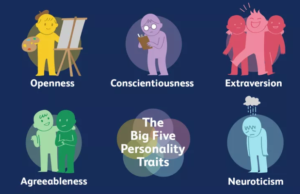This test is the most commonly accepted accurate measure of basic personality. These metrics are used in countless psychological studies. In some of my writing, I need to refer to the Big 5 and wanted an easily found reference.
Many researchers believe that there are five core personality traits.
- Openness
- Conscientiousness
- Extraversion
- Agreeableness
- Neuroticism.
These “big five” are broad categories of personality traits. The test results show you as low or high in each area. Your basic personality type can be understood as the mix of all these traits at the high or low levels measured in the test.
These five categories are usually described as follows:
Openness (sometimes called intellect, imagination)
This trait features characteristics such as imagination and insight. People who are high in this trait also tend to have a broad range of interests. They are curious about the world and other people and eager to learn new things and enjoy new experiences.
People who are high in this trait tend to be more adventurous and creative. People low in this trait are often much more traditional and may struggle with abstract thinking.
High
- Very creative
- Open to trying new things
- Focused on tackling new challenges
- Happy to think about abstract concepts
Low
- Dislikes change
- Does not enjoy new things
- Resists new ideas
- Not very imaginative
- Dislikes abstract or theoretical concepts
Conscientiousness
Standard features of this dimension include high levels of thoughtfulness, good impulse control, and goal-directed behaviors. Highly conscientious people tend to be organized and mindful of details. They plan ahead, think about how their behavior affects others, and are mindful of deadlines.
High
- Spends time preparing
- Finishes important tasks right away
- Pays attention to detail
- Enjoys having a set schedule
Low
- Dislikes structure and schedules
- Makes messes and doesn’t take care of things
- Fails to return things or put them back where they belong
- Procrastinates important tasks
- Fails to complete necessary or assigned tasks
Extraversion
Extraversion (or extroversion) is characterized by excitability, sociability, talkativeness, assertiveness, and high amounts of emotional expressiveness. People who are high in extraversion are outgoing and tend to gain energy in social situations. Being around other people helps them feel energized and excited.
People who are low in extraversion (or introverted) tend to be more reserved and have to expend energy in social settings. Social events can feel draining and introverts often require a period of solitude and quiet in order to “recharge.”
High
- Enjoys being the center of attention
- Likes to start conversations
- Enjoys meeting new people
- Has a wide social circle of friends and acquaintances
- Finds it easy to make new friends
- Feels energized when around other people
- Say things before thinking about them
Low
- Prefers solitude
- Feels exhausted when having to socialize a lot
- Finds it difficult to start conversations
- Dislikes making small talk
- Carefully thinks things through before speaking
- Dislikes being the center of attention
Agreeableness
This personality dimension includes attributes such as trust, altruism, kindness, affection, and other prosocial behaviors. People who are high in agreeableness tend to be more cooperative while those low in this trait tend to be more competitive and sometimes even manipulative.
High
- Has a great deal of interest in other people
- Cares about others
- Feels empathy and concern for other people
- Enjoys helping and contributing to the happiness of other people
- Assists others who are in need of help
Low
- Takes little interest in others
- Doesn’t care about how other people feel
- Has little interest in other people’s problems
- Insults and belittles others
- Manipulates others to get what they want
Neuroticism (sometimes called emotional stability)
Neuroticism is a trait characterized by sadness, moodiness, and emotional instability. Individuals who are high in this trait tend to experience mood swings, anxiety, irritability, and sadness. Those low in this trait tend to be more stable and emotionally resilient.
High
- Experiences a lot of stress
- Worries about many different things
- Gets upset easily
- Experiences dramatic shifts in mood
- Feels anxious
- Struggles to bounce back after stressful events
Low
- Emotionally stable
- Deals well with stress
- Rarely feels sad or depressed
- Doesn’t worry much
- Is very relaxed